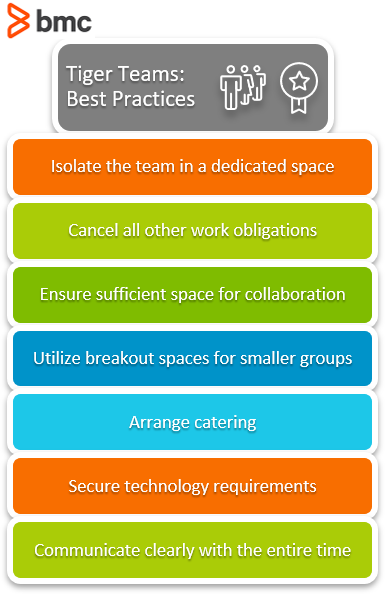The concept of a Tiger Team is not new. But it might be just the approach you need in order to solve a problem that is severely detrimental to:
- Your customers
- Your ability to deliver services
- Your company’s reputation and wallet
Let’s take a look at how to use tiger teams successfully.
(This article is part of our IT Leadership & Best Practices Guide. Use the right-hand menu to navigate.)
What is a tiger team?
A tiger team is a group of cross-functional experts brought together to solve a specific problem or critical issues.
According to a 1964 definition, a tiger team consists of:
‘A team of undomesticated and uninhibited technical specialists, selected for their experience, energy, and imagination, and assigned to track down relentlessly every possible source of failure in a spacecraft subsystem.’
These teams had been pulled together in military and other settings for many years but came to public attention dramatically in 1970 when NASA brought together a tiger team who were charged with bringing the astronauts aboard the crippled Apollo 13 spacecraft back to earth alive.

Mission Control during final 24 hours of Apollo 13 mission. April 16, 1970 (Source)
How tiger teams work
You don’t have a pre-determined tiger team that you call together every time you have a critical issue you are struggling to solve. The team that solves one issue is very unlikely to be the same team—with the same skillsets—that solves the next issue.
Instead, a tiger team will be handpicked for the situation you are facing at that time. Participants in a tiger team might include any mix of:
- Internal staff
- Vendors
- Subject matter experts who are not connected to your organisation
Tiger teams will be assigned to investigate possible solutions to unique situations or problems. Any team will be populated with mature experts who:
- Appreciate the criticality of the task they are facing
- Understand what needs to be done
- Work well with others
- Demonstrate strengths including a diversity of knowledge, a single focus/purpose, and organizational agility
Crucially, the people in your tiger team must be removed from the grind of business as usual. You cannot afford for them to be distracted by their day jobs. Their full attention needs to be applied to resolving the issue at hand. (This ensures full focus and maximum efficiency, saving time and money in the long run.)
Once the tiger team completes the assigned task—solving the issue—the team will be disbanded. Its members will go back to their normal roles.
(Explore IT teams you might draw upon for your tiger team.)
Considerations for building a tiger team
It is possible that one tiger team may not be enough. Highly complex problems may require more than one team to resolve.
Using the principles of best practice in problem management, each team should only be looking at one problem—a single object and a single fault. If you discover during your investigations that you are looking at multiple contributing issues, then either:
- Split your tiger team
- Build a new one to investigate each separate cause
(Look at reactive & proactive problem management.)
It is essential that a tiger team can concentrate on their specialist area and not be distracted by other, potentially conflicting, issues.
You must clearly define the result you expect your tiger team to deliver, defining and understanding what “done” looks like. (Remember, done is a relative term.) Tiger teams are expensive resources, so you don’t want them to be wasting time on non-critical issues. Make sure reach tiger teammate understands the boundaries of the problem you are asking them to solve.
At the onset, clearly state the expectations, rules of engagement, and team and project boundaries. If you do not, you may encounter several risks:
- Team members understood the issue differently. This murkiness will hinder any issue resolution before it gets underway.
- The team may start applying short-term fixes, and sometimes multiple fixes at the same time. A common refrain is “Just a second…try it now.” The danger here is that you no longer understand your starting point—the true problem you’re trying to solve, not work around.
- The team gets confused. Every time the team meets, they look at a different symptom, with no strategic direction.
- Lack of resolution. Once the initial emergency is over, people stop attending meetings and the team isn’t always sure what fixed the issue
- The team skips final determinations and lessons learned. The risk here is that if you don’t allow time to document lessons learned or understand the root cause, the issue might not be as resolved as you think it is.
- Scope creep. Scope creep is a real danger. When discussion wanders to other topics, beyond the team’s original purpose, the tiger team will fail to be productive.
(Discover the #1 success factor in any lessons learned or portmortem report.)

Tiger team best practices
Of course, tiger teams aren’t only about defining the boundaries to solve the problem—they require logistics and management.
Some housekeeping tasks that need to be considered when assembling your team:
- Isolate the team in a dedicated space. War rooms are specific spaces for dedicated events and problem-solving (not routine meetings), and it might be just what you need for a tiger team. Of course, make sure everyone in the team has the appropriate access to your war room.
- Cancel all other work obligations. Block off all team members’ calendars with individual all-day appointments so no other meetings sneak in.
- Ensure sufficient wall space for collaboration.
- Allow for breakout spaces for small groups to work together.
- Arrange catering. Keeping your team together during breaks increases collaboration time.
- Locate and have access to all technology requirements, like test environments, additional hardware, smart screens, etc.
- Communicate clearly and with the entire team. Create a team on your messaging app (Teams, Slack, etc.) and add everyone to it. Create an email distribution list, a Jira or Trello board or similar, and a shared documents folder.
When to form a tiger team
One thing that I would urge is to create a tiger team sooner rather than later. Weigh up the cost vs. benefit equation.
How much is the issue you are dealing with costing the business each day—not just financially, but reputationally as well? If you are getting close to the promised resolution time and are not well on the way to restoring service, it is time to get the experts to work.
Of course, not every incident or issue should have a tiger team. But certainly some will require it.
I have worked in an organization that refused to form a dedicated team to work on a major issue…until the pain experienced by the organization and its customers had reached the top levels of management. By that time, so many attempts to fix the issue had been made, further complicating the situation, that it took weeks of concentrated, and very expensive, effort to restore full service.
The entire time this was happening, the organization’s reputation was suffering, and we were being featured regularly in the media as a result. If a tiger team had come together as soon as it was obvious that we didn’t understand the root cause, the path to resolution would have been much easier and faster.
Bringing top internal and external experts together to resolve a difficult issue is not a cheap option. It’s certainly not one that needs to happen for every situation that is proving difficult to resolve.
But, if your organizational reputation is being damaged, or the viability of the business is threatened, do not hold back. The cost, while often high, will be justified.
Related reading
- BMC Service Management Blog
- Incident Management vs Problem Management: Differences Explained
- The Incident Commander (IC) Role Explained
- Roles & Responsibilities in Change Management
- What Is an IT Steering Committee?
- How Service, Business Relationship & Product Management Work Together
These postings are my own and do not necessarily represent BMC's position, strategies, or opinion.
See an error or have a suggestion? Please let us know by emailing [email protected].






